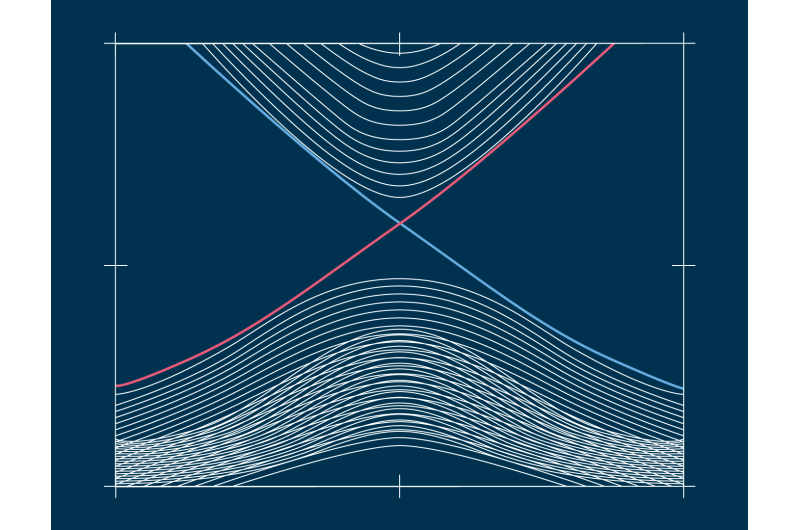Physicists study magnetic impurities in topological insulators

A group of physicists from MIPT and the Landau Institute for Theoretical Physics of the Russian Academy of Sciences are now one step closer to finding applications for topological insulators—materials with remarkable electrical properties, which until recently, were regarded as merely hypothetical. The researchers gained insights into the interaction between the atoms of magnetic impurities in such materials.
Topological insulators are a major discovery of 21st century physics. They were first predicted theoretically and only then observed experimentally. The bulk of such materials display typical semiconductor behavior. But their properties on the surface (at the edge) are very similar to those of metals. For example, electrical current can flow freely on their surfaces. Their unique properties are expected to be useful for building electronic circuits with minimal heat loss, quantum computers, and other advanced devices.
However, to make practical devices based on topological insulators, it is necessary to understand how their properties are affected by structural imperfections, such as the presence of atoms with a nonzero magnetic moment. The magnetic moment of an atom characterizes the strength of the magnetic field that the atom is capable of creating.
The interaction between atoms with magnetic moments—these include iron and manganese—has been investigated in many studies. It can occur in metals and is then called the Ruderman-Kittel-Kasuya-Yosida interaction, in honor of the four theoretical physicists who studied it as early as the mid-1950s. It also occurs in semiconductors, in which case it is known as the indirect exchange interaction. This type was originally theoretically studied by Bloembergen and Rowland in 1955. Another significant contribution to the study of the indirect exchange interaction was made by A. Abrikosov, a Soviet and American physicist and Nobel laureate who addressed the fundamental questions of condensed matter physics. Understanding the indirect exchange interaction—i.e., the binding energy between magnetic atoms and its dependence on temperature and the distance between the atoms—allows scientists to predict how the magnetic moments of these atoms will be aligned at low temperatures in a given material.
In their new paper, which was published in Physical Review B, the researchers examined the interaction between atoms with nonzero magnetic moments near the edge of a two-dimensional topological insulator. Igor Burmistrov, a researcher at the Landau Institute for Theoretical Physics, and Pavel and Vladislav Kurilovich, students of the Section of Problems in Theoretical Physics of the Department of General and Applied Physics, MIPT, studied the indirect exchange interaction between manganese atoms in a two-dimensional topological insulator based on a CdTe/HgTe/CdTe quantum well.
The notion of a "quantum well" means that a thin layer of mercury telluride, or HgTe, is sandwiched between two layers of cadmium telluride, CdTe. The two compounds have different quantum properties confining electrons to the mercury telluride layer. They are, in a way, trapped at the bottom of the well and unable to get out unless they happen to have a specific energy.
Burmistrov says, "The two atoms with magnetic moments can interact in different ways, depending on their positions: If both of them are near the edge, they behave as if they were in a metal, but when both of them are situated away from the edge, they interact the way they do in a semiconductor."
The researcher also explained what makes two-dimensional topological insulators special: "In a two-dimensional topological insulator, quasiparticles move in a plane because the size-quantization energy is higher in the quantum well." A system is called quantized when its energy can only assume discrete values, and size quantization refers to when this arises due to the limited size of the system. Particles in thin films behave in ways that are different from how they behave in classical systems, such as a piece of copper wire or a semiconductor crystal.
The theoretical analysis, most importantly, resulted in the prediction of a new type of indirect exchange interactions between atoms with magnetic moments in a two-dimensional insulator. On the one hand, it is similar to the analogous interaction in metals; on the other hand, it resembles what typically happens in semiconductors. Such an unusual combination dominates the interaction between pairs of magnetic atoms, one of which is near the edge and another away from it. Despite the fact that these theoretical findings do not have any immediate applications, they are important for further studies of the effect of magnetic atoms on the electric current along the edge of a two-dimensional topological insulator.
More information: V. D. Kurilovich et al. Indirect exchange interaction between magnetic impurities near the helical edge, Physical Review B (2017). DOI: 10.1103/PhysRevB.95.115430
Journal information: Physical Review B
Provided by Moscow Institute of Physics and Technology





















